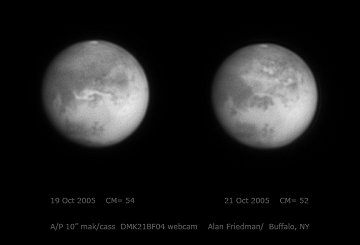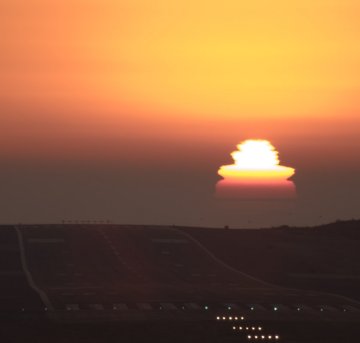 Would you like a call when the space station flies over your backyard? Sign up for SpaceWeather PHONE.
Would you like a call when the space station flies over your backyard? Sign up for SpaceWeather PHONE.
AURORA WATCH: A solar wind stream will buffet Earth's magnetic field this weekend, possibly sparking a geomagnetic storm. Sky watchers especially in Alaska and Canada should be alert for auroras.
MARTIAN DUST STORM: A huge martian dust storm, in progress, is "re-writing the map of Mars," says amateur astronomer Alan Friedman of Buffalo, New York. To prove his point, he arranged two images of Mars taken 48 hours apart side-by-side for comparison:

It's the same planet, but the markings look different. Note, for example, the sinuous bright feature in the Oct 19th image (left); that's dust blowing down the canyons of Valles Marineris. On Oct 21st (right), the same region looks unremarkable. The canyon-dust must have either settled or moved on to other places
Dust storms are an important and dynamic form of Martian weather. Sometimes they grow to envelop the whole planet. What will this storm do next? Stay tuned.
CALIFORNIA SUNSETS: If you live in California, watch out for weird sunsets. Kevin Baird at the Palomar Airport in Carlsbad, CA, photographed this one on Oct. 13th:

"At first the cloudless sky suggested [we would have] a 'boring' sunset," says Baird. Instead, it was unforgettable.
Les Cowley and Andrew Young, experts in atmospheric optics, have an explanation: "Sunsets like these are mirages and, lately, conditions in coastal California have been just right for them. The cold California Ocean Current cools the air next to the ocean surface. Above that, warm dry air driven by high pressure over Utah and Nevada creates a temperature inversion, which bend the rays from the setting sun to make fantastic shapes. Watch them carefully because they often show a brilliant green flash."

